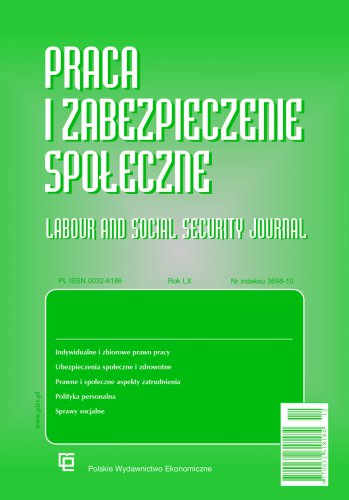Nomadicity in the digital era of work – impact on the concept of place and time of work
The concept of the workplace and working time is considered to be crucial for establishing the existence of an employment relationship, although in the nomadic model is equally crucial to deprive work of attachment to a place and blur time boundaries – so as to adjust it to individual preferences. This undoubtedly also has consequences for the element of subordination, especially with its construction adopted in Poland, because those one of the most important spheres of power of the employer – place and time – are almost eliminated in the nomadic model. The nomadic model is proliferating thanks to the ubiquity of personal digital technologies and information infrastructures coupled with changing work norms. This model and less radical models of work performed by means of distance communication certainly do not determine the direction of employment law development, but their context prompts reflection in what direction labor law should go and what is the area of research that should be undertaken, so to shape the labor law system in a way that meets the needs of business.
References
Antonacopoulou, E. P., & Georgiadou, A. (2021). Leading through social distancing: The future of work, corporations and leadership from home. Gender, Work & Organization, 28(2), 749–767.
Aoun, A., Ilinca, A., Ghandour, M., & Ibrahim, H. (2021). A review of Industry 4.0 characteristics and challenges, with potential improvements using blockchain technology. Computers & Industrial Engineering, 162, 107746.
Bakhshi, H., Downing, J., Osborne, M. & Schneider, P. (2017). The Future of Skills: Employment in 2030. London: Pearson and Nesta, 1–124.
Borowicz, J. (2012). Określanie w umowie o pracę miejsca wykonywania pracy. Monitor Prawa Pracy 8, s. 416 – 418.
Chobot, A. (1998). Czas pracy w znowelizowanym kodeksie pracy. Wydawnictwo Poznańskie.
De Spiegelaere, S., & Piasna, A. (2017). The why and how of working time reduction. European Trade Union Institute.
Fana, M., Tolan, S., Torrejón, S., Brancati, C. U., & Fernández-Macías, E. (2020). The COVID confinement measures and EU labour markets. Luxembourg: Publications office of the European Union.
Greenstein, S. (2021). Remote Work. IEEE Micro, 41(3), 110–112.
Główny Urząd Statystyczny (2021). Wpływ epidemii COVID-19 na wybrane elementy rynku pracy w Polsce w drugim kwartale 2022 r., 9.09.2022 r., Warszawa: GUS.
Hensellek, S., & Puchala, N. (2021). The emergence of the digital nomad: a review and analysis of the opportunities and risks of digital nomadism. The flexible workplace: Coworking and other modern workplace transformations, 195–214.
Knell, M. (2021). The digital revolution and digitalized network society. Review of Evolutionary Political Economy, 2(1), 9–25.
Książek, D. (2013). Miejsce pracy jako istotny element umowy o pracę. Wolters Kluwer.
Lucker J, Hogan S, Bischof T. (2017). Navigating the future of work: can we point business, workers and social institutions in the same direction? Deloitte Review (21). 1–22.
Mariotti, I., Di Marino, M., & Bednáø, P. (2022). The COVID-19 pandemic and the future of working spaces (p. 270).
Taylor & Francis. Matyjas-Łysakowska P. (2021). Stałe miejsce pracy, W: M. Mędrala (Red.), Praca zdalna w polskim systemie prawnym, Wolters Kluwer.
Miguel, C., Lutz, C., Majetić, F., Perez Vega, R., & Sánchez-Razo, M. (2023). It's not all shiny and glamorous: loneliness and fear of missing out among digital nomads. Hawaii International Conference on System Sciences.
Mouratidis, G. (2018). Digital nomads: travel, remote work and alternative lifestyles.
Naumowicz, K. (2021). Cyfrowi nomadzi na polskim rynku pracy – wybrane aspekty prawne pracy zdalnej w sektorze cyfrowym. W: B. Godlewska- -Bujok, K. Walczak (Red.) Zatrudnienie w epoce postindustrialnej. C.H.Beck.
Phillips, S. (2020). Working through the pandemic: Accelerating the transition to remote working. Business Information Review, 37(3), 129–134.
Richter, S., & Richter, A. (2020). Digital nomads. Business & Information Systems Engineering, 62, 77–81.
Schlagwein, D., & Jarrahi, M. H. (2020). The Mobilities of Digital Work: The Case of Digital Nomadism. In ECIS.
Shepherd, J. (2004). What is the Digital Era?. In G. Doukidis, N. Mylonopoulos, & N. Pouloudi (Eds.), Social and Economic Transformation in the Digital Era (pp. 1–18). IGI Global. https://doi.org/10.4018/978-1-59140-158-2.ch001
Sobczyk, A. (2005). Zasady prawnej regulacji czasu pracy. „ABC” Oddział Polskich Wydawnictw Profesjonalnych.
Wang, B., Schlagwein, D., Cecez-Kecmanovic, D., & Cahalane, M. C. (2020). Beyond the factory paradigm: Digital nomadism and the digital future (s) of knowledge work post-COVID-19. Journal of the Association for Information Systems, 21(6), 10.
Warhurst, C., & Hunt, W. (2019). The digitalisation of future work and employment: Possible impact and policy responses (No. 2019/05). JRC Working Papers Series on Labour, Education and Technology.
Zieliński, T. (1985). Zarys systemu prawa pracy. Warszawa, t. 2.

